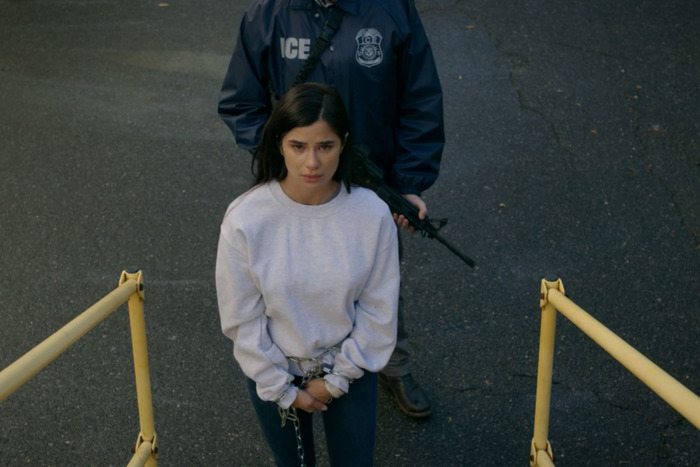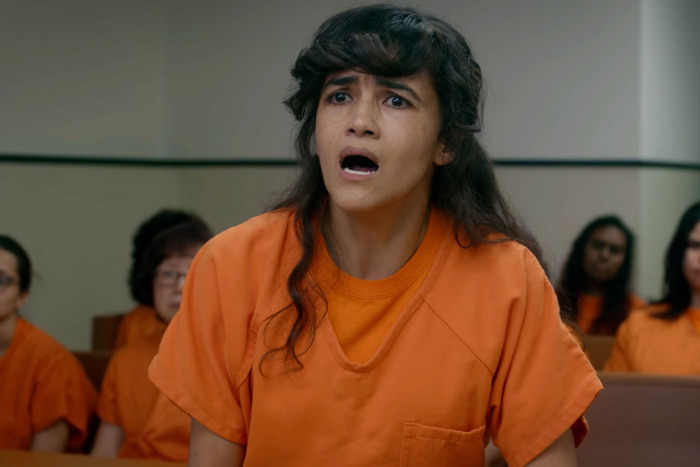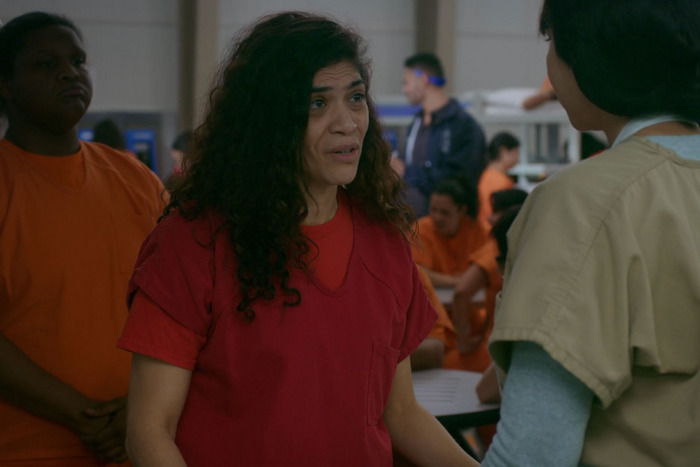Why orange is the new black brought the immigration crisis to Litchfield
By Maria Elana Fenadez From Vulture

One of the most haunting images of Orange Is the New Black’s seventh and final season is of flirtatious, clever Maritza Ramos sitting on an airplane with ten other women, being deported to who knows where. While “Hush” by Trills plays on the soundtrack, the former inmate, who was absent in the show’s sixth season, stares blankly, her eyes swollen from crying, her fun-loving spirit wrecked. It is the last time Orange fans see this half of the Flaritza duo, who begins the season on parole — until Immigration and Customs Enforcement (ICE) raids a club and detains her, and she learns the hard way that her mother lied to her about her U.S. citizenship.
Maritza’s story is one of several sobering threads the Orange writers wove into this season exploring immigration detention, family separation, and other discriminating, dehumanizing aspects of immigration policy, set in motion when the private company that bought the prison opened an immigration detention center at the Litchfield campus at the end of last season. When Maritza arrives at the center this season, viewers see another familiar face: Blanca, who was picked up by ICE agents moments after being released from prison in the sixth season finale. Without warning or fanfare, Maritza is deported in the fifth episode, “Minority Deport.” In the despairing scene in the airplane, the other women disappear from the screen one by one until Maritza is alone.
Then Maritza vanishes, too. Although actress Diane Guerrero, who plays Maritza, was in production on her other show Doom Patrol, she returned to the seminal Netflix series for its final season because of U.S immigration policy’s traumatizing mark on her life. The only U.S. citizen in her household, Guerrero came home from school at age 14 to find that her parents were deported. Because the government took no measures to take care of her, friends stepped in to help her. Her family remains in Colombia.
The airplane scene, which concludes the episode, was the last one Guerrero filmed for the series and marks the first time she has been willing to perform her personal pain, despite several other offers to tell her story through fictional characters over the years. But doing so on Orange felt appropriate, she told Vulture, because her bosses and colleagues on the show were supportive of her when she decided to go public with her story a few years ago.
“It was extremely emotional,” said Guerrero, who told her harrowing story in her memoir In the Country We Love: My Family Divided, which was published in 2016. “Obviously, it brought back up feelings of when I was a child and knowing that’s what my parents went through. My parents have told me stories of what it was like on the plane, how lonely and how cold it felt. You’re handcuffed and you’re sitting there with an agent. On a plane, you imagine going on a trip or visiting your family, everything beautiful. But when you are put on a plane forcefully, leaving your family behind, you can imagine the trauma that makes you feel, the loneliness that you feel. I felt all of that by proxy. I was acting out what my parents have gone through.”
Through the years, Orange Is the New Black has explored many social issues, including prison overcrowding, corruption, privatization, racial tensions, transgender visibility, and Black Lives Matter. Immigration detention has been on showrunner Jenji Kohan’s mind since she opened the writers’ room for the sixth season. Originally the writers intended to introduce it as a story line last season, but couldn’t fit it in with the new world of maximum security they were exploring in the aftermath of Poussey’s death and the ensuing prison riot. Instead, they opted to introduce it at the end of last season with the opening of immigration detention centers across the country, and the shocking turn in Blanca’s story after she is released early from prison for a crime viewers learn this season she did not commit.
“What was interesting is, we didn’t all feel the same about immigration going in,” said executive producer Carolina Paiz, whose Guatemalan mother gave birth to her in Miami so there would be one U.S. citizen in the family in case they had to flee their homeland. “There were a lot of people who were like, ‘Why can’t they do it the legal way?’ Just being judgmental about certain situations. We had differing points of view, which I think is healthy and good and is the case in America as a whole. But by allowing these stories into our lives and homes, perspectives changed. It hit home. It became real. It’s about people. This isn’t a story about statistics or policy or about these foreign people that we don’t know. My hope is that because these are characters that we let into our homes and hearts, and things happen to them, people will feel what these characters feel and understand the immigration crisis in a different way.”

Diane Guerrero returned to the series for its final season because of U.S immigration policy’s traumatizing mark on her life.Photo: Netflix
From the beginning, the writers knew they wanted Guerrero to return to the show, since Maritza and Blanca were the two Latinas in Litchfield who are not Puerto Rican. With her winged eyeliner and sassy attitude, Martiza and her best friend and fellow YouTube personality Flaca became fan favorites. In the finale story, Maritza’s big heart betrays her when guards observe her passing out information to other detainees about how to contact lawyers using a secret code, since detainees don’t have the right to make phone calls. The next time viewers see her, she is being walked to the airplane in handcuffs.
“We knew we wanted Maritza to be deported because we wanted it to feel like a member of your family was gone,” Paiz said. “We wanted viewers to feel the shock of that, for the abruptness to be jarring. Diane’s activism and story is an inspiration to us and certainly influenced us.”
But it wasn’t just Guerrero’s life story that made an impact on Kohan’s team. In May 2018, the show’s 13 writers visited Adelanto ICE Processing Center, the largest detention center in Southern California, with Freedom for Immigrants, a national advocacy group seeking to end immigration detention. “I don’t think they bothered to Google us because I don’t think there’s any way they would let us in if they had,” Paiz said. “We took a bus and drove two hours to the most depressing place in the world.”
The group toured the facility, seeing firsthand how both men and women are being housed, and visiting the center’s medical and dental facilities, as well as the yard. “We know prisons and we imagined it was going to be like camp, like a minimum-security prison, but looser than that,” Paiz continued. “What shocked us was that it was no different than a maximum-security prison, except that they have less rights. They have no right to an attorney. They have no right to a phone call. It was the most horrifying realization for people who already have worked within that world to realize that it gets darker.”
After the tour, the writers met with detainees behind a glass partition. “When we left there, we all had migraines,” Paiz recalled about the five-hour visit. “We all got sick.”
But the research continued. Former prisoners who were transferred to detention centers and other legal experts visited the writers’ room to talk about their experiences. A couple of writers attended removal hearings, including one for juveniles where they learned children age 2 and older are expected to defend themselves, which they included in the 11th episode “to show the ridiculousness and heartbreak of this,” Paiz said. Consultant Lindsay Toczylowski, co-founder of Immigrant Defenders Law Center in Los Angeles, also guided them behind the scenes.
“We did so much research, we read so much, we talked to so many people, and we talked about these stories so much in the room that it became normal for me to cry three times a day,” Paiz said. “It was like, If Carolina’s not crying, the story’s not working. It just became a normal part of our life to be in grief about what was happening and how bad the situation was getting.”
At one point, the writers’ room board had 20 potential immigration story lines they were considering. Some were knocked out of the running when similar stories appeared in the news, such as a baby snatched from his mother’s arms at the border; other times, the writers dialed it back, not wanting to overwhelm the audience. “We would write these really sad, terrible scenes and then give them to our consultant to see if it felt real and she would say that it was actually worse than we were describing it,” Paiz said. “A lot of these stories were overwhelming in their tragedy and we wanted to find the right balance.”

The purposefully vague yet tragic ending given to Carla (Karina Arroyave) provoked one of the biggest fights in the writers’ room. Photo: Netflix
In the end, they settled on three new characters in addition to Maritza and Blanca: Carla (Karina Arroyave), a widowed mother who is separated from her two young sons and deported; a queer Egyptian woman named Shani (played by Marie-Lou Nahhas) who becomes Nicky’s love interest and is also deported; and an indigenous detainee named Santos (played by Melinna Bobadilla) who was raped crossing the border and is being denied an abortion by ICE. “People come here for different reasons and in different ways and not everyone’s story is the same,” Guerrero said. “So I was really hoping we’d show a range of the different ways someone could be affected by the immigration system.”
The stories rang so true that Jackie Cruz, who plays Flaca — the other half of Flaritza — says it did not require much acting. Flaca is part of the kitchen staff that gets assigned to cook daily for the immigration detainees, and gets wrapped up in helping them by making phone calls to lawyers and family members on their behalf.
“It feels way too close,” Cruz said. “There are a lot of us that don’t talk about things because we want to protect our families. It’s scary to believe that this could happen to someone you love. I was really glad that we’re shining a light to this, but it was really hard finding out all the shit that really went down and living it.”
In the center, Carla, a Salvadoran immigrant, teaches Blanca how to research the law and defend herself at the removal hearings. Eventually, Carla’s efforts to save herself fail and a judge orders her deportation — which is not the worst thing that happens to her.
“When the whole family-separation issue came to light, I had trouble sleeping,” said the Colombian-born Arroyave. “I wanted to go visit the children in the detention center in New York, and, of course, we couldn’t do that. I thought, What can I do? I really feel like life sent me this huge gift of portraying one of these women. If we could just sway one person, if we could just show what’s missing, which is the humanity, and let that dictate what people believe.”
Carla’s story provoked one of the biggest fights in the writers’ room. Some writers thought it was tragic enough to end with Carla on a bus without her children in the 11th episode, “God Bless America,” which Paiz wrote. Others thought they should push harder, reasoning that a mother like Carla would do everything she could to return for her boys. “I was one of the people who was saying this was already devastating,” Paiz said. “And then the day I argued that, I came home to find a New York Times article about a woman from Guatemala who had died crossing the border to get her children. I was like, oh God, that’s a sign. Fine, you’re all right.”
In the series finale, Carla attempts to cross the border on foot with a group of other immigrants being led by a coyote. She trips and breaks her ankle and the man abandons her in the desert. Viewers never see her again. “It’s purposefully vague, but I think it feels horrifyingly bleak,” Paiz said.
Arroyave agrees: “I was grateful that they took it to this ultimate place. It was right to end in devastation. If it ends with her being deported, it’s horrible, but there’s hope that she can come back and get the kids. It’s not as effective, I think. They did leave it open, but it doesn’t look good for her.”
Things end on a more hopeful note for badass rebel Blanca, but not before the Dominican inmate who took the fall for the elderly woman she cared for, and who is actually a legal permanent resident, spends a few months in detention and her boyfriend, Diablo, is deported. Before Blanca is housed at the Litchfield center, she spent time in a transitional facility in Arizona, which viewers see in a flashback. In a poignant scene in the third episode, “And Now Brown Is the New Orange,” Blanca calls Diablo (Miguel Izaguirre) to let him know what happened to her and to ask him not to wait for her anymore.
“That was the most emotional scene of the season for me,” said Laura Gómez, who plays Blanca, a tough woman who once pissed herself to avoid being touched by the Litchfield prison guards. “The energy in the room was so hard. The art department had set out a camp like the ones we see on the news, with old mattresses in the background and extras covered with those foil blankets. I didn’t have to push too much. I felt it very deeply. This is all in the news, but it’s not being taken as seriously as it should be, so doing this felt important. Sometimes the irony is that fiction can be more informative and powerful than reality.”
Once Blanca begins learning from Carla about the system and how she might be able to defend herself, she transforms from a dejected, depressed detainee to the empowered woman Orange fans have come to appreciate. Blanca is released from the detention center and, by the end of the season, is a free woman with a green card. She chooses to go to Honduras to be with Diablo, a suggestion Gómez made to the writers who were considering sending her to her native country, the Dominican Republic.
“Her choice is to go for the person she loves, no matter where and no matter what,” Gómez said. “They are a nontraditional couple and they have the most unlikely love story of all, yet the most stable love story, really. I appreciated so much that the writers asked for my opinion. The reality is, there are different circumstances in Central America than there are in the rest of the continent, so the stakes would be higher. Within the dysfunctionality of it all, the choice is beautiful, and a bit poetic as well.”

Laura Gómez had a hand in crafting a more hopeful resolution to Blanca’s story. Photo: Netflix
Gómez hopes viewers will be taken in by Orange’s humanization of Latino and Muslim characters in the same way the cast was. “The demonization of immigrants right now, especially Latinos, Middle Easterners, and Muslims, it just feels like there’s an aggressive agenda against the humanization of these people and their reality,” she said. “We’re also ignoring history and the role of the United States as to why these people are here. I hope what this season is doing is moving us in the right direction.”
As the national debate over immigration has become more heated and the reality of how detainees of all ages are being treated grows starker, Paiz said it felt cathartic to write and produce the show’s final season. “The whole time President Trump has been president he’s been targeting us in the most vicious ways, so the timing to hit with this, unfortunately, will always be right as long as he’s still there. We are all so worried, but as writers, this is what we can do. We can write about it and maybe that starts a conversation.”
For more on this story go to; https://www.vulture.com/2019/07/orange-is-the-new-black-immigration-storyline-bts.html?utm_source=Sailthru&utm_medium=email&utm_campaign=Vulture%20-%20July%2029%2C%202019&utm_term=Subscription%20List%20-%20Vulture%20%281%20Year%29





